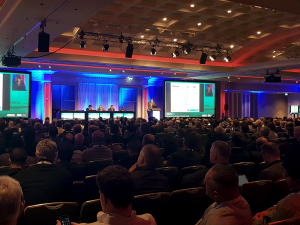Emerging research presented at ESOU17 is showing encouraging results on the use of PSMA-PET for the diagnosis of lymph node staging. However, Prof. Markus Graefen (Hamburg, DE) did start his talk by reminding the audience on day two of ESOU17 that a “meticulous histologic work-up of lymph nodes retrieved by an extended lymph node dissection still has the highest accuracy for detection of lymph nodes metastases,” citing Kiss et al (2016).
Graefen reviewed the latest recommendations and pros and cons of established technologies like CT and MRI and Sentinel LN techniques. “While CT and MRI are the current standards, they are only of limited value for LN staging. Sentinel lymph node detection has several drawbacks, including a substantial rate of false negative nodes, results differing on the choice of injection site and these techniques have not been investigated sufficiently.”
Choline-PET was evaluated in a 2013 meta-analysis of ten studies and 441 patients (Evangelista et al), revealing a good specificity of about 95% but also a low sensitivity of 50%. Graefen concluded that choline PET/CT has no place for up-front staging in nodal metastasis. “Choline-PET also depends on the choline metabolism in cancer cells, which is often not altered. Choline-PET CT should really only be considered in recurrent disease with a PSA > 1 ng/ml.”
PSMA-PET
Sensing the high interest in the room for the potentially “game-changing” PSMA-PET, Prof. Graefen referred back to Prof. Briganti’s talk on the day before. “Urologists are certainly ‘in love’ with some new technologies, including robotic surgery, targeted MRI prostate biopsies, and now PSMA-PET. But we must not be blinded by it.”
PSMA-PET certainly has promising results in recent publications. Its sensitivity gives a much-improved lesion to background ratio compared to choline-PET. PSMA is a transmembrane protein which is expressed in about 90% of PCa cells, and its expression increases with disease progression. It binds to the extracellular PSMA domain.
Some drawbacks that urologists should be aware of: 68-Ga-PSMA PET availability is still limited. When asked, only a very, very small minority of the audience had regular access to PSMA-PET. PSMA is also not prostate-specific, and the detection of lymph nodes of <5mm (the majority of lymph node metastases) is still a problem. The huge difference in cost compared to regular CT/MRI in some countries is another drawback for its adoption, a point raised by audience discussion.
“Nevertheless, PSMA-PET CT has the highest sensitivity and specificity, and has the potential to replace other imaging techniques in the near future. It remains our task to evaluate the clinical implications. How will this change management and, subsequently, patient care? We have yet to see if improved imaging leads to a survival benefit or if it might become a source of overdiagnosis and overtreatment.” Graeffen cautioned.
Prof. Graeffen spoke as part of the morning session of ESOU17, which mainly focused on various current aspects of lymph node diagnosis and extended lymphadenectomy. Three video presentations gave delegates advice on an open approach, a laparoscopic approach and finally a robotic approach.





